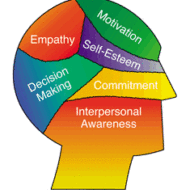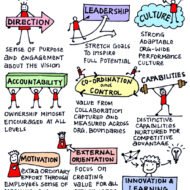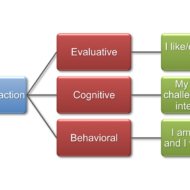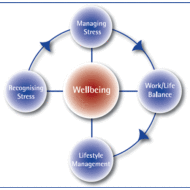Posted by Managementguru in How To, Organisational behaviour
on Mar 30th, 2015 | 0 comments

This discussion is centred around an article from WIKIHOW.COM and an infographic from AMERICAN EXPRESS.COM both talking about “Inter Personal Skill Development at workplace via Clear Communication and Body Language.” Inter personal relationship between personnel in workplace has become a serious issue of debate and most of the organizations spend maximum effort and money to make organizational atmosphere bearable devoid of tension and heat. The wikihow article places four important points before us to be considered: Building strong relationshipsDemonstrating ethical behaviorCommunicating clearly andWorking effectively in teams. As Beatrice Vincent rightly puts it “The people with whom you work reflect your own attitude. If you are suspicious, unfriendly and condescending, you will find these unlovely traits echoed all about you. But if you are on your best behavior, you will bring out the best in the persons with whom you are going to spend most of your working hours.” Conflict is the in-thing to be resolved in a work place which is achieved only through motivating the work-force to accomplish some common objectives, that is, the objectives of the organization. How to Develop Interpersonal Skills This infographic stresses the importance of body language like gestures, eye contact, eye rolling, dressing etc. which openly reveals your inner thinking. Explicitly revealing your frutration or unpleasantness over something or someone is definitely not going to help you in getting along with other employees. If your mannerisms do not reflect your self-control, you are in big trouble. Being open and honest may be contextual but being open and rude becomes subjective. 6 Body Language Mistakes to Avoid The most basic of all human needs is the need to understand and be understood. According to Stephen Covey “The Inside-Out approach to personal and interpersonal effectiveness means to start first with self; even more fundamentally, to start with the most inside part of self — with your paradigms, your character, and your motives. The inside-out approach says that private victories precede public victories, that making and keeping promises to ourselves recedes making and keeping promises to others. It says it is futile to put personality ahead of character, to try to improve relationships with others before improving ourselves. So, first understand where you really stand in terms of your EQ or EI (Emotional Intelligence) the vital quality that decides the kind of inter personal relationship you are going to enjoy with your colleagues. Be emphathetic and open minded and never jump to any...

Posted by Managementguru in Human Resource, Quotes and Quotes Only, Training & Development
on Jul 6th, 2014 | 0 comments

Popular HR Quotes by Industry Experts and Management Scholars We have compiled 50 top notch hr quotes from doyens in the field of business and management that will sure fire inspire you with creative ideas. 1. “Great Vision Without Great People Is Irrelevant.” -Jim Collins, Good To Great 2. “Human Resources Isn’t A Thing We Do. It’s The Thing That Runs Our Business.” -Steve Wynn, Wynn Las Vegas 3. “You Need To Have A Collaborative Hiring Process.” -Steve Jobs, Apple 4. “You Can’t Teach Employees To Smile. They Have To Smile Before You Hire Them.” -Arte Nathan, Wynn Las Vegas 5. “Never Hire Someone Who Knows Less Than You Do About What He’s Hired To Do.” -Malcolm Forbes, Forbes Top 50 HR Quotes 6. “When Hiring Key Employees, There Are Only Two Qualities To Look For: Judgement And Taste. Almost Everything Else Can Be Bought By The Yard.” John W. Gardner 7. “Recently, I Was Asked If I Was Going To Fire An Employee Who Made A Mistake That Cost The Company $600,000. No, I Replied, I Just Spent $600,000 Training Him. Why Would I Want Somebody To Hire His Experience?” -Thomas John Watson Sr., Ibm 8. “It’s More Than Just Selling Pizzas. It’s Being A Good Fit For The Community. We Hire Based On The Betterment Of The Community As Much As Anything.” -Mark Starr, David’s Pizza. 9. “You Can Have The Best Strategy And The Best Building In The World, But If You Don’t Have The Hearts And Minds Of The People Who Work With You, None Of It Comes To Life.” -Renee West, Luxor And Excalibur Hotel 10. “I am convinced that nothing we do is more important than hiring and developing people. At the end of the day you bet on people, not on strategies.” -Lawrence Bossidy, Ge CURRENT TRENDS IN HRD 11. “Do Not Hire A Man Who Does Your Work For Money, But Him Who Does It For The Love Of It.” -Henry David Thoreau, Life Without Principle 12. “If You Think Hiring Professionals Is Expensive, Try Hiring Amateurs” -Anonymous 13. “The Key For Us, Number One, Has Always Been Hiring Very Smart People.” -Bill Gates, Microsoft 14. “Time Spent On Hiring Is Time Well Spent.” -Robert Half 15. “I Hire People Brighter Than Me And Then I Get Out Of Their Way” -Lee Iacocca, Ford 16. “You Cannot Push Anyone Up The Ladder Unless He Is Willing To Climb.” -Andrew Carnegie 17. “Management Is Nothing More Than Motivating Other People.” -Lee Iacocca, Ford 18. “There Are Few, If Any, Jobs In Which Ability Alone Is Sufficient. Needed, Also, Are Loyalty, Sincerity, Enthusiasm And Team Play.” -William B. Given, Jr. 19. “When People Go To Work, They Shouldn’t Have To Leave Their Hearts At Home.” -Betty Bender 20. “One Machine Can Do The Work Of Fifty Ordinary Men. No Machine Can Do The Work Of One Extraordinary Man.” -Elbert Hubbard 21. “To Find Joy In Work Is To Discover The Fountain Of Youth.” -Pearl S. Buck 22. “One Of The Symptoms Of An Approaching Nervous Breakdown Is The Belief That One’s Work Is Terribly Important.” -Bertrand Russell 23. “Opportunity Is Missed By Most People Because It Is Dressed In Overalls And Looks Like Work.” -Thomas A. Edison 24. “Far And Away The Best Prize That Life Offers Is The Chance To Work Hard At Work Worth Doing.” -Theodore Roosevelt 25. ”Being Busy Does Not Always Mean Real Work. The Object Of All Work Is Production Or Accomplishment And To Either Of These Ends There Must Be Forethought, System, Planning, Intelligence, And Honest Purpose, As Well As Perspiration. Seeming To Do Is Not Doing.” -Thomas A. Edison 26. “Going To Work For A Large Company Is Like...

Posted by Managementguru in Change management, Human Resource, Organisational behaviour
on May 20th, 2014 | 0 comments

Organizational Climate – An Analogy Organizational climate is a measure of the feel of the internal environment of an organization which is perceived by an outsider and/or an employee according to their business with the organization. Organizational climate has a great effect on employees’ behavior. If the climate of an organization is open and friendly, employees feel relaxed and if it is very formal, then such a comfort level may not be felt. Climate for an organization is somewhat like personality for a person. “Just as every individual has a personality that makes him/her unique, an organization has a climate that clearly distinguishes its personality from other organizations. Human religionists introduced the concept of organizational climate in the late 1940’s. Now this has become a very useful metaphor for thinking about and describing the social aspects of a firm. Some definitions: “A set of characteristics that describe an organization and that i. Distinguish one organization from another ii. Are relatively enduring over a period of time and iii. Influence the behavior of people in the organization.” – Forehand and Gilmber “A mutually agreed internal (or molar) environmental description of an organization’s practices and procedures.” – Benjamin Schneider (1975) “A relatively ending quality of the internal environment that is experienced by the members, which influences their behavior and can describe in terms of values of a particular set of characteristics of the organization.” – Renato Tagiuri (1968) Features: It is an abstract and intangible concept. But it exercises a significant impact on the behavior and performance of organization members. It is the perceived aspect of organization’s internal environment. It refers to the relatively enduring characteristics which remain stable over a period of time. It gives a distinct identity to organization and differentiates it from others. It is a total expression of what the organization is. It is the summary perception which people have about organizations. It is a multi-dimensional concept. It consists of all organizational factors – authority pattern, leadership pattern, communication pattern, control etc. Elements of Organizational Climate: Individual Autonomy: The extent to which employees are entrusted with to make decisions, the degree to which they are free to manage themselves and have the freedom to exercise their responsibility come under the purview of individual autonomy. Position Structure: It means the extent of direct supervision, formalization and centralization in an organization. Reward Orientation: The degree to which an organization rewards individuals for hard work or achievement. It will be high when an organization orients people to perform better and rewards them for doing so. Task Orientation: If the outlook of the top management is task oriented, the employees will have to speed up the pace of work to please their bosses. Relations Orientation or Consideration: Here the climate is conducive and supportive where the managers are relations-oriented while dealing with their sub-ordinates. The needs and aspirations of the workers will be given due importance resulting in enhanced team spirit. Job Satisfaction: The workers feel happy if the jobs are designed to allow the worker to use their innovative skills. Morale: Morale represents a composite of feelings, attitude and sentiments of organizational members towards the organization, superiors and fellow workers. If it is high, there will be an atmosphere of co-operation and if it is low, there will be conflicts and poor co-operation among the workers. They will also feel dis-oriented in their work. Control: The control systems may be either rigid or flexible. An impersonal or bureaucratic atmosphere is seen in the former situation where the scope of self-regulation will be minimum. DOWNLOAD THE PDF...

Posted by Managementguru in Business Management, Human Resource, Organisational behaviour, Principles of Management, Training & Development
on Apr 5th, 2014 | 0 comments

Attitude and Job Satisfaction What is attitude? Attitudes are evaluative statements or judgments concerning objects, people or events –Stephen Robbin. They also represent an ‘affective orientation towards an object.’ It simply means what one feels and thinks about something. Elements of attitude: Cognitive components – opinion or belief Affective components – emotion or feeling Behavioral components – intention to behave The interaction of these three components determines the way in which an individual develops an attitude towards something. Sources: Society Friends Teachers Family Members It also forms on the basis of the level of admiration we have over an object or persons. People also try to imitate others and attitudes are gradually formed on that basis also. In some attitudes formed are less stable, in some they even dominate the whole life. Types: Organizational behavior uses the concept of attitudes in relation to nature of the job and its influence on the performance of the persons. Accordingly, Job Satisfaction Job Involvement and Organizational Commitment, are the three kinds of attitude a person could have with respect his / her job or organization. Job Satisfaction: In “Job Satisfaction “, Stephen P. Robbins writes about five factors which make a person satisfied with his or her job. These factors are Mentally challenging work Equitable rewards Supportive working conditions Supportive colleagues and Personality-job fit. Cranny, Smith and Stone define job satisfaction as employees’ emotional state concerning the job, considering what they anticipated and what they actually got out of it. In fact, an employee with low expectations can be more satisfied with a certain job than someone who has high expectations. If one’s expectations are met or surpassed by the job, then one is happy and satisfied with the job. Job Involvement: Job involvement has been defined as an individual’s psychological identification or commitment to his / her job. As such individuals who display high involvement in their jobs consider their work to be a very important part of their lives- In other words for highly involved individuals performing well on the job is important for their self esteem. Organizational Commitment: Three important elements of a committed individual would be Identification with the organization’s goals and/or mission Long-term membership in the organization and intention to remain with the organization, often termed loyalty High levels of extra role behavior- behavior beyond required performance- Often denoted to as citizenship behavior or pro-social behavior. Cognitive Dissonance Theory: Leon Festinger developed this theory which explains the relationship between attitude and behavior. It refers to”any incompatibility that an individual might perceive between two or more of his or her attitudes, or between his or her behavior and attitudes.” Attitude Surveys: This is a tool that helps to collect information about the levels of attitude among the people. In most companies these kinds of surveys are conducted with the help of different rating scales like Likert scale offering five or seven alternative choices for each of the statement developed for attitude measurement. Summary: Research conducted on attitude and job satisfaction in Indian workers has made clear certain points as given below: Attitude is positively correlated with efficiency Absenteeism will bring down satisfaction levels Unions, negatively affect the employee attitude and job satisfaction Attitude researches and surveys will improve...

Posted by Managementguru in Business Management, Change management, Human Resource, Organisational behaviour, Principles of Management
on Mar 31st, 2014 | 0 comments

India often looks at Japanese or American models to comprehend the concepts of management. In reality, Indian scriptures can be considered as treasuries of management. The Bhagavat Gita, the Vedas and the Epics highlight the true spirit of working together and the need for de-stressing the self for enhanced performance levels. The idea of NISHKAMYAM (to perform one’s own work without expecting a result) is truly said to be the highest ideology preached by Lord Krishna. What Induces Stress? A dynamic condition in which an individual is presented with an opportunity or confronted with a demand, related to what she or he desires and for which the outcome is uncertain but important, can be called a stressful situation. The consequences of stress in an organizational set up express themselves in the form of physiological, psychological or behavioral symptoms, which are harmful to the individuals who experience high levels of stress. Symptoms of stress: AnxietyDepressionIncreased job dissatisfactionAbsenteeismDecline in productivityRapid turn overHigh blood pressureHeart diseasesHead aches Stress Can be Motivating: While long term stress is harmful to the individual and organization as well, it is said that short term stress serves the purpose of task accomplishment by individuals or groups, within the stipulated time. It serves as a motivation factor rather than a causative agent of frustration. It has been proved by scientists and medical researchers that stress has a direct effect on the metabolism of a person, that causes increase in heart and breathing rates, increase in blood pressure, thus inducing heart attacks. Equally important are the behavioral and attitudinal changes that are created by stress, which cannot be overlooked. Job Satisfaction: Psychological symptoms arise due to job-related dissatisfaction, boredom, work pressure, irritability and procrastination. Sometimes forceful involvement may also lead to decreased job satisfaction. The job to be carried out can be finished at the particular time if the individual is able to give one’s best shot. But when it is performed under stress, they complete the job with dissatisfaction. When the incumbent is asked to perform a task that lacks clarity, naturally ambiguity arises in his mind followed by anxiety. Behavioral Symptoms of Stress Changes in productivity levels, absence, and rapid staff turnover are stress symptoms of behavioral nature. It might be expressed even in the form of increased smoking, consumption of alcohol etc., Say for instance, in production department, when there is a need to supply a product in a very limited time, the workers may be active initially, but the performance slows down when they get totally tired or dissatisfied with the work. Again the demand by the superior adds additional stress that reaches unmanageable levels. Similarly, people taking care of administration, banking, marketing and other office related works fall a prey to stress. How to manage stress? From an organization view point, it is believed that a limited amount of stress may work wonders in terms of performance, with stress acting as a “positive stimulus”. But even low levels of stress are likely to be perceived as undesirable from an individual’s stand point. How could be the notion of management and individuals be different on the acceptable levels of stress? It does not solve the purpose. Individuals have to understand that, they have to live up to the expectations of the management in order to enhance their credit ratings, in terms of promotion and pay. They have to understand that challenges are to be perceived as opportunities to prove their mettle. Self and situational analysis, work analysis, time management and physical well- being are some techniques that practically solve problems of stress. “De-stressing the Self” Techniques for Employees Organisations can reduce stress of the employees...










